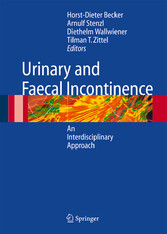Suchen und Finden
Service
Urinary and Fecal Incontinence - An Interdisciplinary Approach
Horst-Dieter Becker, Arnulf Stenzl, Diethelm Wallwiener, Tilman T. Zittel
Verlag Springer-Verlag, 2005
ISBN 9783540274940 , 498 Seiten
Format PDF, OL
Kopierschutz Wasserzeichen
1 Epidemiology of Urinary Incontinence by Steinar Hunskaar (p. 4-5)
The understanding of epidemiology – the study of the distribution and determinants of disease – is critical in the search for the risk and protective factors that lead to primary or secondary disease prevention.This chapter reviews some of the knowledge of the epidemiology of urinary incontinence (UI). The review uses only a fraction of the high-quality, population-based studies available. More comprehensive reviews have been published (Hampel et al. 1997, Thom 1998, Hunskaar et al. 2000, 2002).
1.1 Definitions
Studies of disease frequency should rely on a very specific definition of the condition under investigation. The lack of unifying definitions for UI is a fundamental problem in assessing and comparing the findings in different studies. The International Continence Society (ICS) previously defined "urinary incontinence" as "a condition where involuntary loss of urine is a social or hygienic problem and is objectively demonstrable." From 2002 the definition reads "The complaint of any involuntary leakage of urine." The old definition was not achievable outside clinical settings. It added a subjective aspect ("problem") and therefore confounded the analyses of prevalence and risk factors. The new definition is well suited for epidemiological studies, but not appropriate for defining a patient. It should therefore be combined with validated instruments for type, severity, and QoL, in addition to investigations, for the clinical setting.
"Prevalence" is defined as the probability of being incontinent within a defined population and at a defined point in time. The concept is important for establishing the distribution of the condition in the population and for projecting the need for health and medical services."Incidence" is defined as the probability of developing the condition under study during a defined time period. Incidence is usually reported for 1-, 2-, or 5-year time intervals. Epidemiological surveys must often take a pragmatic approach and therefore define "incontinence type" based on the symptoms alone. The classification can be made either by researchers or by the respondent’s confirmation of a typical description. Clinical assessment allows for more differentiation of subtypes, but is difficult to perform on a large-scale basis. Severity of incontinence is another important factor for the estimate of prevalence. "Severity" can be defined by factors such as frequency, amount, and subjective bother (Sandvik et al. 2000).
1.2 Epidemiology of Nocturnal Enuresis
Most epidemiological studies link primary and secondary enuresis together and may include both monosymptomatic and polysymptomatic cases. Also, enuresis is defined in different ways, and in many papers there is no frequency defined at all. The best studies are longitudinal cohort studies, but many are cross-sectional (Krantz et al. 1994). In some cultures, parents are more complacent about bedwetting than in others and do not regard it as a problem requiring attention.
Nocturnal enuresis is caused by relative nocturnal polyuria and/or nocturnal bladder overactivity combined with lack of arousal at the time when the bladder needs to be emptied. These factors have a different weight in different enuretic children. The pathophysiology is thus a mixed mechanism, which explains difficulties encountered when trying to define enuresis in a consistent way. Stringent epidemiological studies would need to evaluate nocturnal urine production, nocturnal bladder activity, sleep and arousal in each of the probands. Needless to say, there is no large populationbased study using such diagnostic evaluation.
1.2.1 Survey Studies
Prevalence of nocturnal enuresis at age 7 years is significant since many children start school then, meaning more exposure to the environment and thus a greater awareness of the problem.At this age, the prevalence of nocturnal enuresis seems to be between 7% and 9% (Spee-van der Wekke et al. 1998,Hunskaar et al. 2002). In the early ages, the prevalence in boys is reported to be higher than in girls by a 2 : 1 ratio in Western countries. In studies from other countries, the figures are more similar in boys and girls,but there is always a predominance of boys. It seems that the sex difference diminishes with age and becomes less obvious among older children. In a French study (Lottmann 1999), the severity and consequences of enuresis were reported: 66% had more than one wet night per month,37% more than one wet night per week, and 22% wet the bed every night. Regarding consequences, 42% were "bothered a lot" while 15% were "not bothered at all" by their enuresis. In contrast, 92% of the mothers declared that the enuresis had no significant effect on family life or the child’s behavior at school. Fourteen percent of mothers punished their child and only 13% intended to seek treatment for their child. Even if there are some ethnic and cultural differences in the prevalence of enuresis, with higher rates generally reported from Eastern countries, there is nonetheless a remarkable similarity of prevalence rates of nocturnal enuresis in populations from all parts of the world. Steinar Hunskaar



